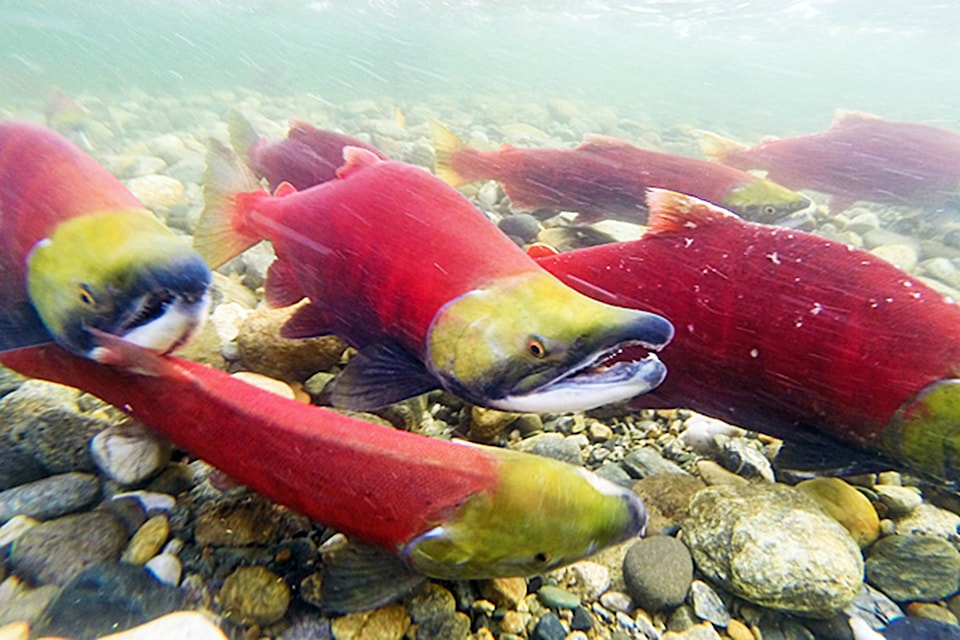Well, they are starting to come, perhaps in dribs and drabs, but sockeye salmon are starting to show up in the Adams River.
I went to take a look and was able to spot a few pools with fish that had already turned their spawning colours, but nowhere near the numbers I was expecting – hoping – to see.
In the last few months there have been all sort of estimates and ‘guess-timations’ of the number of sockeye that are expected to return to spawn in the Adams. Anywhere from six to 29 million fish. Granted, it is only September and the largest contingency of spawners won’t be here until October, but as I looked down into the fast flowing waters of the Adams, I couldn’t help but wonder.
If the sockeye do show up in large numbers that would be great, or at least promising. If the six million estimate proves to be more accurate, then the guessing game starts all over again as to what the future holds for the sockeye. Either way, there are still a lot of questions yet to be answered and, when all is said, the Fraser River (and subsequently the Adams River) sockeye salmon stocks still appear to be in trouble. There’s just too many unknowns.
Related: Column: Hot weather adds to concerns for returning sockeye salmon
We’ve had study after study, not to mention the $37 million Cohen Commission, and the best we can come up with is an estimation of somewhere between six to 29 million fish. Surely they can be a little bit more precise than that, and, even more assuredly, they need to do significantly more to protect the Fraser River sockeye stocks.
Canada’s Policy for Conservation of Wild Pacific Salmon was formulated in 2005. It stipulates that “wild salmon populations will be maintained by identifying and managing conservation units.”
I’m not sure exactly what that means but it sounds a little vague when it comes to putting plans into place.
While the Fisheries Act allows the federal minister of Fisheries and Oceans Canada to “set regulations for the protection and sustainable use of fisheries resources and their habitat,” one of the problems is there is currently little substantive legislation to protect wild salmon stocks in B.C. waters.
Related: Shuswap salmon subject of symposium
If the government does not yet have a clear understanding of what the problems are facing maturing salmon in ocean waters, they do have more than a clear understanding of what the problems are facing salmon stock in Interior waters. Why haven’t they done more to protect the sockeye salmon runs?
Department of Fisheries and Oceans scientists say they are actively working to solve the mystery of why B.C.’s salmon stocks are in decline. In a five-year study off Vancouver Island, a team of DFO fisheries biologists have also tried to determine why it has become so difficult to predict salmon runs.
One DFO statement said that, “It used to be fairly clear how many salmon would survive and return to rivers a few years later. The prediction was based on the number of salmon that left the river. Now the process has become far more complicated… with ocean conditions, temperature and food supply playing a much greater role in the number of salmon that will return.”
Another DFO statement says a possible explanation for the changing stock numbers may lie in the coastal waters where salmon spend the first few months of life: “What we think we’re seeing is changes in the food supply. On B.C.’s southwest coast, for example, there are five main species of Pacific salmon: pink, chum, sockeye, chinook and coho. All of them eat plankton and all spend some of their first year at sea in the Georgia Strait.”
Recently, DFO scientists have been looking at the theory that “even a one-degree increase in water temperature can effectively reduced the food supply for salmon which arrive later in the season, and this decrease in food supply makes it harder for those species to fatten up and survive the first winter.”
Again, the DFO is working on it. Maybe another few studies and/or another commission will help. In the meantime, I guess the sockeye will just have to be patient and wait for the DFO to find a way to make better estimates – and maybe, just maybe, come up with some sort of possible plan of action.
@SalmonArm
newsroom@saobserver.net
Like us on Facebook and follow us on Twitter
